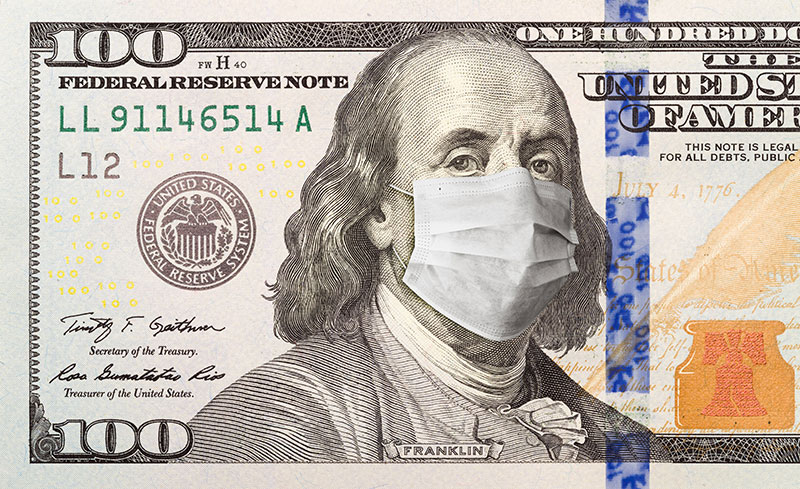Well, it is April 6th, 2020, and many, if not most, commercial landlords and tenants are wondering about rent. As governmental orders around the country shutter many retail business, it’s only a matter of time before rent is due and decisions need to be made whether to pay it, and if not paid, how to collect it. Obviously this has a spiraling effect: as rents are not paid, landlords will be unable to make payments to their lenders; and then those lenders cannot pay their lenders or investors; and so on, and so on.
Some landlords and tenants are reacting immediately. Taubman Centers, one of our nation’s largest mall owners, sent letters to every one of their tenants stating that due to its ongoing obligations to lenders, utilities, etc., “[a]ll Tenants will be expected to meet their Lease obligations.” While the statement was tempered in a subsequent press release, Taubman clearly staked out their position. On the tenant side, The Cheesecake Factory notified its landlords that it will not be paying April rent for any of its 294 restaurants, again clearly setting a tone.
In times like these, it is our position that two initial responses are critical. The first of those is to take a breath. Take the time to educate yourself on the current situation, and then formulate a rational plan based upon that information. The second, communicate. Lenders, landlords and tenants must reach out to each other and communicate in an open and honest fashion about what needs to happen over the coming weeks and months. In my opinion, only clear headed thinking and timely communication will allow all sides to weather the storm and prosper in the aftermath.
The Process Starts & Ends With the Lease
Bottom line, landlords and tenants need to remember that the lease agreement controls their relationship. Thus, all decisions need to be made in conjunction with the lease terms. It is a binding contract and provides benefits and places obligations on both parties. Thus, you must dig it out of whatever file drawer you put it in when the lease was signed, and read it, in detail.
Lease Clauses to Consider
- Operating Covenants: What requirements are placed upon the tenant regarding if, when, and how long they must be open for business. This is critical to understand, as a violation of any such requirement may trigger a default.
- Co-Tenancy Provisions: These provisions typically provide benefits to tenants based upon the actions of other tenants (usually anchors) in the same building or complex. A tenant may be able to assert such a clause in the event that a large anchor tenant was forced to close by government order.
- Notice Provisions: You must gain a thorough understanding of what notices must be given by both landlord and tenant, and the timing of each. Failure to adhere to the requirements of these provisions may result in a waiver of the benefit you are seeking.
- Default Provisions: These spell out exactly what actions, or lack thereof, constitute a default under the lease and trigger additional benefits and obligations to the parties. It is essential to everyone that these provisions are thoroughly understood and every effort is made to avoid triggering them, if possible.
- Force Majeure Clause: This clause provides protection to the parties of a contract when performance of obligations required by the contract cannot be performed because of unforeseen events or events outside the control of the parties. Frequently the types of events will be listed in the clause. Generally speaking, a party seeking the protections of this clause must demonstrate the unforeseen nature of the event, and/or that the event renders performance impossible. Courts typically narrowly construe these provisions, often limiting them to just the list of items enumerated in the clause. The clause should be reviewed with your attorney to determine whether it can be applied and excuse performance by either party.
- No-Waiver Provisions: As we all know, leases are drafted in a landlord friendly fashion. These particular clauses help landlords avoid unintentionally waiving a lease provision by requiring waivers to be in writing and that any act, or failure to act, on its own, is not a waiver.
- Dispute Resolution Clauses: These clauses often detail the path that must be followed if a dispute among the parties arises. Almost always, they start with Notice, but then chart a path can include negotiation, mediation, and other courses before litigation can commence. Knowing and understanding the path you are embarking on is critical at the outset of a dispute.
Other Considerations
In addition to the actual lease terms, landlords and tenants must consider numerous other factors that will ultimately play a role in how the question of rent payments is resolved.
Landlord Considerations
First, and foremost, landlords must weigh all decisions in light of their obligations to their lenders. Ideally, all loan payments are up to date before a landlord begins discussions with a lender. It is always an easier time when you are not behind in payments.
But let’s face it, at this time, lenders know you will be calling. So the real question becomes what can you do to address tenants who can’t pay the rent, but remain in your lender’s good graces. The ultimate goal is to reach a balance between the goal of maximizing long term asset value against short term vacancy rate concerns. I will provide some ideas on how to work through tenants inability to pay rent below, but all of these ideas must be considered in light of the landlord’s obligation to its lender. Landlords must be careful not to activate any loan recourse triggers that could put other landlord assets at risk. Bottom line, in most cases, landlords should not consider rent relief without the support of its lenders.
Evaluate all of your building operations. Like the governments did, determine what is “essential” and what can be reduced or eliminated during the crisis. This includes maintenance staff, HVAC run times, outside lighting, building operations times, and upcoming planned improvements. Go through your current vendor list and think about how that cost can be reduced.
Turning to your tenants, landlords must first consider the type of tenants they are dealing with. While a quality tenant used to mean creditworthiness, in the time of COVID-19, quality means something else entirely. Tenants need to be individually evaluated with a criteria geared toward the current landscape. Whether national, regional, or a mom and pop, quality now is defined by factors such as: (1) overall ability to weather significant reductions or elimination of cash flows for weeks or a few months (90 days seems to be the window); (2) was the tenant deemed “essential” by the controlling governmental entity; (3) what resources are available from the government’s various stimulus programs; (4) is a post COVID-19 consumer likely to immediately return to this particular type of tenant or will the effects linger; and (5) the desire of the tenant to continue operations after the immediate crisis is resolved. While certainly not an exhaustive list, it is a starting place for landlords to draft a plan of action. Having a clear plan, as quickly as possible, that addresses issues raised by all parties will make the coming discussions and negotiations much easier than shooting from the hip with each individual tenant.
Landlords must balance each tenant’s request for rent reduction against the time it will take to back-fill the space with a replacement tenant. More often than not, right now, it will likely be more beneficial to work with the tenant you have under lease.

Tenant Considerations
This is an opportune time for tenants to truly evaluate all aspects of their particular business model to determine what is and more importantly what isn’t working. This information will be crucial when trying to demonstrate to the landlord why you need a particular concession.
First, and foremost, you must be able to demonstrate, as clearly and succinctly and possible, what your past revenue performance was, what it is currently, and a logical projection of the immediate future. Armed with this information, at a minimum, you can demonstrate in concrete terms the financial impact the pandemic had on you business, and project a timeline to get back to where you were. This goes beyond just opening your Quickbooks during your call with the landlord. Distill your information into a concise picture of the revenue situation, and send it to your landlord prior to the initial call, so that both of you are on equal footing when discussing it.
Second, and of equal import, is to know what you want from the landlord. Be ready with a specific request that you can articulate clearly, and provide data to support the need. Putting the time into preparation will make for an easier conversation with the landlord.
Research what other resources are available to you. Your first search should be for the Paycheck Protection Program (PPP)(part of the CARES Act). The PPP is a $349 billion dollar small business loan program that allows eligible businesses to borrow up to 2.5 times their normal payroll to keep employees working through June, 2020. These loans will be completely forgiven if (1) the loan proceeds are used to cover payroll costs, and most mortgage interest, rent, and utility costs over the 8 week period after the loan is made; and (2) employee and compensation levels are maintained. Check out the Small Business Administration’s fact sheet now, because you can start applying on April 3, 2020.
Contact your insurance agent to determine what coverages you have and whether any would provide coverage for this type of event. It may be that this type of loss is excluded, but an argument could be made if you were required to close by your state or municipality.
Last, be ready with items that you can, or are willing to give back in compromise. Review notes or drafts during the lease negotiation process looking for the terms that the landlord sought but did not get. You may be able to offer these items by way of compromise to get what you need. If you are closed, are there parking spots, or signage that could be made available to other tenants that remain open. Think outside the box here for anything that may be available to you to entice the landlord to accept your proposal.
Types of Concessions to Consider
What can you ask for or offer during a conversation about rent payments during the pandemic? Well, the answer is largely dependent upon your individual situation. That said, however, you can certainly contemplate any of the concessions I list here, or a combination thereof. In no particular order, here are some ideas that have gained some traction around the country:
- One Month at a Time: Many landlords have adopted a wait and see approach, where each month a discussion will take place, and a decision will be made with the most up to date information available.
- Forgiving The Rent: Depending on your particular situation, this may be a viable option. Just like free rent during initial upfit, many landlords would consider this a cost of doing business. For the majority, however, this is likely not feasible.
- Reducing the Rent: This solution can take many forms. Due to mandatory closures, you may be able to drastically reduce the CAM charges associated with the property. You could also reduce the base rent by an agreed amount, or have the rent tied to a percentage of a tenant’s sales.
- Deferring the Rent to a Later Date: This option still requires full payment of the rent, but requires it in the future when a degree of normalcy has returned. The question of course is how far into the future. Many request that it be added onto the end of the existing term, but for most landlords, that is too long to wait. On the opposite end, may landlords are offering the option but requiring full payment by the end of the calendar year. With all the uncertainty surrounding a rebound, that may be too soon. Another question is how the deferred rent will be paid back. Is it paid in a lump sum, doubling up on rent payments, or something else?
- Treating Deferred Rent as a Loan: If contemplating a longer payback schedule, the parties may consider a loan with interest attached. In such a situation, the pay-off is extended, but at least there is compensation for a landlord that agrees to wait.
- Using Security Deposits: Depending on your location, a landlord and tenant may agree to allow use of the security deposit as payment for rent, to be repaid by tenant over time. The legality of this in a particular location must be investigated, and if lenders are involved, a landlord will need them to agree to such a plan. If it can work, it may be a great short term solution.
- Subletting A Portion of Your Space: While some research will be required, you may be able to find companies that need additional space during the pandemic and you could ease your rent burden by clearing space for them.
Conclusion
In these uncertain times, information and communication are critical. Information is the key to reaching effective solutions, and communicating it in a clear, concise, and frequent manner will go a long way toward reaching compromises everyone can live with. Not to mention the opportunity to bolster your reputation and strengthen existing relationships.







